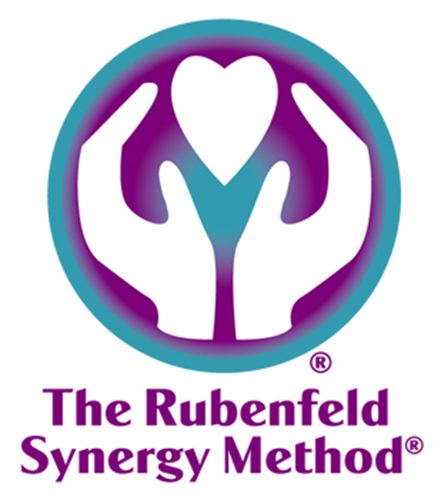 |
| Rubenfeld synergy logo |
The Rubenfeld synergy method is a hybrid of various bodywork and psychotherapy techniques, aimed at accessing stored emotions and memories. This psychophysical approach uses talk, touch, and movement to remove tensions, imbalances, and energy blocks.
Origins
Rubenfeld synergy is a trademarked system for mind-body integration developed during the early 1960s by former orchestra and coral conductor Ilana Rubenfeld. A graduate of the Julliard School of Music, where she studied with Pablo Casals, she played viola, oboe, and piano.

Her method incorporates elements from:
- The body/mind teachings of F. M. Alexander and Moshe Feldenkrais.
- The hypnotherapy methods of Milton Erickson.
- The Gestalt psychotherapy theory and techniques of Fritz and Laura Perls.
Rubenfeld was an Alexander teacher and trainer who studied with the Perls, trained also with Moshe Feldenkrais, and became one of his first teachers in America. Her synthesis of the various elements became Rubenfeld synergy method after Buckminster Fuller suggested the word synergy to her in 1975.
Benefits
Reported benefits include recovery from physical and emotional trauma, release of tension, improved ease of movement, pain management, as well as improved body image, self-esteem, and mind-body awareness.
Description
 |
| Rubenfeld Synergy Method massage creams |
A typical Rubenfeld synergy session lasts between 40 and 60 minutes. The number and frequency of these sessions is determined by the specific needs of the patient.
Rubenfeld synergy may involve gentle touch with “open and listening hands,” but the patient may remain fully clothed. Clients may sit or lay down, or may move about during the session.
A wide range of techniques may be used by the practitioner, including dream work, aura analysis, sound, imagination, breathing exercises, humor, spirituality, and verbal expression. Practitioners say that motions and memories can be “stored” in any part of the body as energy blocks, tensions, and imbalances—holding patterns.
For example, sexually abused women are thought to often store memories from their experiences of abuse in their pelvis. The patient is considered an equal partner in the healing process. There may be considerable emphasis on a lifestyle governed by choices instead of habits.
Precautions
Rubenfeld synergy may involve substantial physical contact. Patients should be aware that traditional psychotherapists often frown upon such touching because of the risk of inducing improper fantasies. As with all therapies involving touch, it is important to ensure that a practitioner is certified to reduce risk of improper behavior.
Side effects
There are few, if any, known side effects.
Research and general acceptance
Some aspects of Rubenfeld synergy method, including psychotherapy techniques, are known and generally respected by the medical establishment. Other aspects, such as aura analysis, are well outside the boundaries of traditional medicine.
Medical practitioners recognize that Rubenfeld techniques may promote relaxation, but some worry that false hope may be given in cases of serious illness.